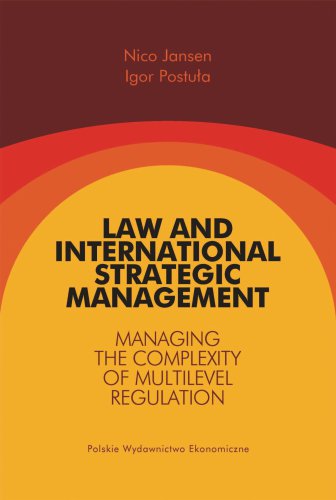Law and International Strategic Management. Managing the Complexity of Multilevel Regulation
Rok wydania: 2022
Miejsce wydania: Warszawa
Wydanie: I
Oprawa: miękka
Format: B5
Dodatkowe informacje: Kolor
This text is the result of cooperation between Polish and Dutch academics and lawyers who both are involved in research, University lecturing and business consulting. The idea to develop a practical guide for (future) business managers and lawyers that presents law from an international business perspective emerged when the authors met at an international study week in Valencia in 2017.
This book combines legal and business concepts into a concise overview of the relationships between regulation and international strategic management and, more specifically, between the legal function in a company and that firm’s corporate strategy. The publication aims to increase awareness among lawyers and managers on the complexity of the regulatory environment(s) in which they respectively manage and support businesses.
Dzieło łączy problematykę nauk prawnych oraz nauk o zarządzaniu i jakości, a także – w mniejszym zakresie – ekonomii i finansów. Autorzy ukazali te elementy zarządzania przedsiębiorstwem, w których praktyczna wiedza prawna wspiera podejmowanie decyzji strategicznych, przyczyniając się do ograniczania ryzyka działania we współczesnym, turbulentnym otoczeniu rynkowym. O kształcie książki zadecydowały również doświadczenia Autorów – niekwestionowanych specjalistów w wymienionych dyscyplinach – których bogate doświadczenie praktyczne i akademickie predestynowało do przygotowania tego interdyscyplinarnego kompendium wiedzy. Książkę powinni docenić zwłaszcza czytelnicy zainteresowani funkcjonowaniem w ekonomiczno-prawnym otoczeniu międzynarodowym.
z recenzji Anny Marii Nikodemskiej-Wołowik, Uniwersytet Gdański
Monografia stanowi oryginalne i ważne opracowanie – zarówno teoretycznie, jak i praktycznie. Autorzy stosują podejście interdyscyplinarne, łącząc problematykę nauk o zarządzaniu oraz prawa. Książka odnosi się do perspektywy trzech różnych systemów prawnych, tj. prawa kontynentalnego, common law oraz prawa islamskiego. Analiza konkretnych instytucji prawnych jest prowadzona na poziomie prawa krajowego (polskiego), międzynarodowego oraz prawa Unii Europejskiej. Autorom udaje się sprawnie zarządzać tą wielopłaszczyznowością dzieła. Dzięki wydaniu w języku angielskim monografia może stanowić źródło wiedzy o polskich regulacjach gospodarczych także dla studentów, akademików i menedżerów z innych krajów. To czyni książkę wyjątkową wśród innych pozycji na rynku wydawniczym.
z recenzji Tomasza Siemiątkowskiego, Szkoła Główna Handlowa w Warszawie
Preface
Introduction
Section 1
Regulatory environment
Chapter 1. The regulatory environment
1.1. Law and business
1.1.1. Challenges
1.1.2. Regulation
1.1.3. Law
1.1.4. Managers and law
1.1.5. Lawyers and managers
1.1.6. Legal system
1.1.7. Business system
1.2. External environment
1.2.1. Strategic input
1.2.2. Specific
1.2.3. Soft law
1.2.4. Self-regulation
1.2.5. Societal expectations
1.2.6. Supervision
1.2.7. Solutions
1.2.8. Services
1.3. Internal environment
1.3.1. Strategic input
1.3.2. Contribution
1.3.3. Value creation and protection
1.3.4. Risk management
1.3.5. Reputation management
1.4. Regulatory SWOT
1.4.1. Strategic fit
1.4.2. Conceptual framework
1.4.3. Strategic decisions
1.5. Legal traditions
1.5.1. Introduction
1.5.2. Civil law
1.5.3. Common law
1.5.4. Religious law
1.6. Multilevel management
Chapter 2. Poland
2.1. Regulatory environment
2.2. Legislation
2.2.1. Sources and levels of law
2.2.2. Legislature and process
2.2.2.1. Legal acts
2.2.2.2. Legislative process
2.2.2.3. Lobbying in Poland
2.2.3. Quality
2.3. Company specifics
2.3.1. Employment
2.3.1.1. Employment contracts
2.3.1.2. Termination
2.3.2. Taxation
2.3.3. Imports
2.4. Enforcement and supervision
2.4.1. Judiciary
2.4.2. Alternative dispute resolution
Chapter 3. The European Union
3.1. Genesis of the European Union
3.1.1. Supranational environment
3.1.2. Historical background
3.1.3. Levels of integration
3.1.4. Integration in the EU
3.1.5. Competences
3.1.6. Business dimensions
3.2. Institutions
3.2.1. Introduction
3.2.2. European Council
3.2.3. European Commission
3.2.4. Council of the EU
3.2.5. European Parliament
3.2.6. Court of Justice of the EU
3.3. Regulatory Environment
3.3.1. Community Acquis
3.3.2. Regulatory Environment
3.3.3 The Brussels Effect
3.4. Lobbying
3.4.1. Interest Representation
3.4.2. Lobby Industry and Market
3.4.3. Lobby Management
3.5. Legislative Process
3.5.1. Ordinary Procedure
3.5.2. European Commission
3.5.3. Council and Parliament
3.5.4. Conciliation and Trilogue
3.5.5. Official Journal
3.5.6. Details
3.5.7. Enforcement
3.6. Strategic Input
Section 2
Property, contracts, companies, and marketing
Chapter 4. Property law
4.1. Property law
4.1.1. Legal and business perspectives on property rights
4.1.2. Principles
4.2. Business functions
4.2.1 Strategic input
4.2.2. Create value
4.2.3. Protect value
4.2.4. Risk management
4.2.5. Reputation management
4.3. Bankruptcy law
4.3.1. Legal consequences of insolvency
4.3.2. Polish bankruptcy and restructuring law
4.4. Mergers and acquisitions
4.4.1. Methods
4.4.2. Controlled auction
4.4.3. MBO – MBI
4.4.4. Divestments
4.5. Polish property law
4.5.1. The types of property rights in Poland
4.5.2. Ownership
4.5.3. Components
4.5.4. Movable or immovable
4.5.5. Registered property
4.5.6. Dismembered rights
4.5.7. Transfer
4.5.8. Financing
4.6. International dimensions
4.6.1. Common law
4.6.1.1. Property
4.6.1.2. Financing
4.6.1.3. Insolvency
4.6.2. Islamic law
4.6.2.1. Property
4.6.2.2. Financing
4.6.2.3. Bankruptcy
Chapter 5. Intellectual property
5.1. Intellectual property rights
5.1.1. Products of the mind
5.1.2. Create value
5.1.3. Protect value
5.1.4. Strategic input
5.1.5. Risk management
5.1.6. Reputation management
5.2. Inventions – patents
5.2.1. Inventions
5.2.2. Multilevel regulation
5.2.3. National level. Poland
5.2.4. Management
5.3. Branding – trademarks
5.3.1. Signs
5.3.2. Multilevel regulation
5.3.3. National level. Poland
5.3.4. Trademarks’ management
5.4. Creativity – copyrights
5.4.1. Principles
5.4.2. Multilevel regulation
5.4.3. National level. Poland
5.4.4. Copyrights’ management
5.5. Exterior – design rights
5.5.1. Principles
5.5.2. Multilevel regulation
5.5.3. National level. Poland
5.5.3.1. Industrial design
5.5.3.2. Utility model
5.5.4. Management
5.6. Other IP and related rights
5.6.1. Database right
5.6.2. Geographical indication
5.6.3. Trade name right
5.6.4. Chips right
5.6.5. Plant Breeders’ Right
5.6.6. Trade secret
5.6.7. Domain name
5.6.8. Portrait rights
5.6.9. Moral rights
5.7. Strategic management
Chapter 6. Contracts
6.1. Contract regulation and management
6.1.1. Principles
6.1.2. Contractual pluralism
6.1.3. Business contracts
6.1.4. Smart Contracts
6.1.5. Contract structure
6.1.6. Contracting process
6.1.7. Lawyers and managers
6.1.8. Contract cycle
6.1.9. Contract management
6.2. Polish contract law
6.2.1. The law of obligations
6.2.2. The conclusion of contract
6.2.3. Negotiation and pre-contractual risks
6.2.4. Formation risks
6.2.5. Offer risks
6.2.6. Contents’ risks
6.2.7. Standard conditions’ risks
6.2.8. Performance risks
6.2.9. Dispute resolution risks
6.3. Common law
6.3.1. Rules of contracts
6.3.2. Pre-contractual
6.3.3. Formation
6.3.4. Non-performance
6.3.5. Interpretation
6.3.6. General terms
6.3.7. Dispute resolution
6.4. Islamic law
6.4.1. Negotiations
6.4.2. Formation
6.4.3. Non-performance
6.4.4. General terms
6.4.5. Interpretation
6.4.6. Dispute resolution
6.5. Enforcement analysis
6.6. Management and contracts
Chapter 7. Corporate law
7.1. Multilevel perspectives
7.1.1. Legal forms
7.1.2. Legal personality
7.1.3. Boards
7.1.4. Corporate governance
7.1.5. Holding organisation
7.1.6. Initial public offering
7.2. Polish corporate law
7.2.1. Sole ownership
7.2.2. Partnerships
7.2.2.1 Civil law partnership
7.2.2.2. Commercial partnerships
7.2.3. Legal persons
7.2.4. Capital companies
7.2.4.1. Limited liability company
7.2.4.2. Joint-stock company
7.2.4.3. Simple joint-stock company
7.2.5. Corporate Governance Code of Polish listed companies
7.2.6. Executive liability
7.2.6.1. Internal liability
7.2.6.2. External liability
7.2.6.3. Criminal liability
7.2.7. Works council
7.3. Common law
7.3.1. Legal forms
7.3.2. Corporate governance
7.3.3. Directors’ liability
7.4. Islamic law
7.4.1. Legal forms
7.4.2. Corporate governance
7.4.3. Director’s liability
7.5. Managerial frameworks
Chapter 8. International commercial contracts
8.1. International contracts and risks
8.2. Applicable law
8.2.1. Principle
8.2.2. CISG
8.2.3. Rome I
8.2.4. Islamic systems
8.2.5. Customary law
8.2.6. Arbitration
8.3. Competent court
8.3.1. Choice of Forum
8.3.2. Brussels I (recast)
8.3.3. Arbitration and Mediation
8.3.4. Islamic Systems
8.4. Carriage contracts
8.4.1. Regulation
8.4.2. CMR
8.5. Risk transfer
8.5.1. Incoterms
8.5.2. Any mode
8.5.3. Waterway
8.6. Credit risk
8.7. The rules of international contracting
8.7.1. Structure
8.7.2. Clauses
8.8. Enforcement
8.8.1. Principle
8.8.2. Brussels I (recast)
8.8.3. New York 1958
8.8.4. Singapore Convention 2019
8.8.5. Islamic systems
8.8.6. Developments
8.9. Polish contract law
8.9.1. Types of contracts
8.9.2. Pre-contractual information
8.9.3. Obligations
8.9.4. Passing of risk
8.9.5. Consumer protection
8.9.6. Private law risks
8.9.7. Public law risks
8.10. Management and international contracts
Chapter 9. Marketing
9.1. Functions and regulation of marketing
9.1.1. Marketing strategy
9.1.2. Marketing mix
9.1.3. Regulation
9.1.4. Marketing regulation in Poland
9.1.5. Contributions
9.2. Non-contractual liability
9.2.1. Types of legal liability
9.2.2. Non-contractual liability in Polish law
9.2.3. Common law
9.2.4. Islamic law
9.3. Marketing communications
9.3.1. The regulation and risks of marketing communication
9.3.2. Advertising
9.3.3. Direct marketing
9.3.4. Social media
9.3.5. Unfair trade practices
9.3.6. Data protection
9.3.7. Personal selling
9.3.8. Websites
9.4. Product
9.4.1. Perspectives
9.4.2. Digital services
9.4.3. Packaging
9.4.4. Product liability
9.4.5. Product recall
9.5. Place
9.5.1. Distribution
9.5.2. Selective distribution
9.5.3. Information obligations
9.5.4. Platforms
9.5.5. Carriage contracts
9.6. Pricing
9.6.1. EU pricing regulation
9.6.2. Polish pricing regulation
9.6.3. Value added tax
9.6.4. Transfer pricing
9.7. Entry strategies
9.7.1. Agents and distributors
9.7.2. Franchising
9.7.3. Wholly-owned subsidiary
9.8. Competition law
9.8.1. Cartels
9.8.2. Abuse of a dominant position
9.8.3. Mergers
9.8.4. State aid
9.8.5. Enforcement and compensation in competition law
9.9. Conceptual frameworks
Section 3
Regulatory services and providers
Chapter 10. Regulatory services
10.1. Legal function
10.1.1. Introduction
10.1.2. Lawyers
10.1.3. Legal department
10.1.4. Compliance
10.1.5. Legal management
10.1.6. Organisation
10.2. Legal services
10.2.1. Make or buy?
10.2.2. Legal professions
10.2.3. Interest representation
10.2.4. Procurement
10.3. Contribution
10.3.1. Managing value
10.3.2. Value opportunities
10.3.3. Costs management
10.3.4. Risk management
10.3.4.1. Introduction
10.3.4.2. Legal risks
10.3.4.3. Compliance risks
10.3.5. Reputation management
10.3.5.1. Reputation risk
10.3.5.2. Reputation management
10.4. Managing Legal
10.4.1. Influences
10.4.2. Objectives framework
10.4.3. Changing Legal
10.4.4. General counsel
10.5. Managing compliance
10.6. Integration framework
10.6.1. Introduction
10.6.2. Management framework
10.7. It takes two to value
References
About the authors
Index
| Kurier Inpost | 14 zł |
| Kurier FedEX | 14 zł |
| Inpost Paczkomaty | 14 zł |
| Odbiór osobisty | 0 zł |
| Darmowa dostawa | od 250 zł |
| Darmowa dostawa w Klubie Książki | od 200 zł |



